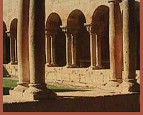


While there are many paths to Santiago, four major routes developed starting from Tours, Vèlezay, Le Puy, and Arles in France, to cross the Pyrenees at the Somport or Roncesvalles passes, joining together at Puente la Reina in Navarra (near Pamplona) to form a single path across northern Spain to the saint's shrine at the Cathedral of Santiago de Compostella. [Due to space limitations the map starts just west of Logroño (La Rioja) - some 75 km from the crossroads at Puente la Reina.]
The Spanish part of El Camino de Santiago runs some 800 km (500 miles) from the Roncesvalles pass through Puente la Reina, La Rioja, Burgos, Leon and finally crossing Galicia to Santiago. While not everyone has the time and energy to repeat the entire road, the Road to Santiago is a fantastic tourist venue for hikers and walkers. The Road crosses some of the country's most spectacular landscapes, and is dotted with beautiful Romanesque and Plateresque churches, chapels, and monasteries - the above photo shows the cloisters at the Silos monastery near Burgos where monks still sing Gregorian chants (they even made a record).
A proper pilgrimage must be made on foot, bicycle or horseback - the pilgrim has the use of free hostels along the route, and gets his pilgrim's passport stamped along the way and certified at the Cathedral in Santiago. Whether you plan to do a proper pilgrimage or not, the Road (or just about any a part of it) is a great way to see Spain, and enjoy the Camino's period architecture, shrines, villages, countryside, and hospitality.
VS Camino links
VS' growing list of The Camino de Santiago links.